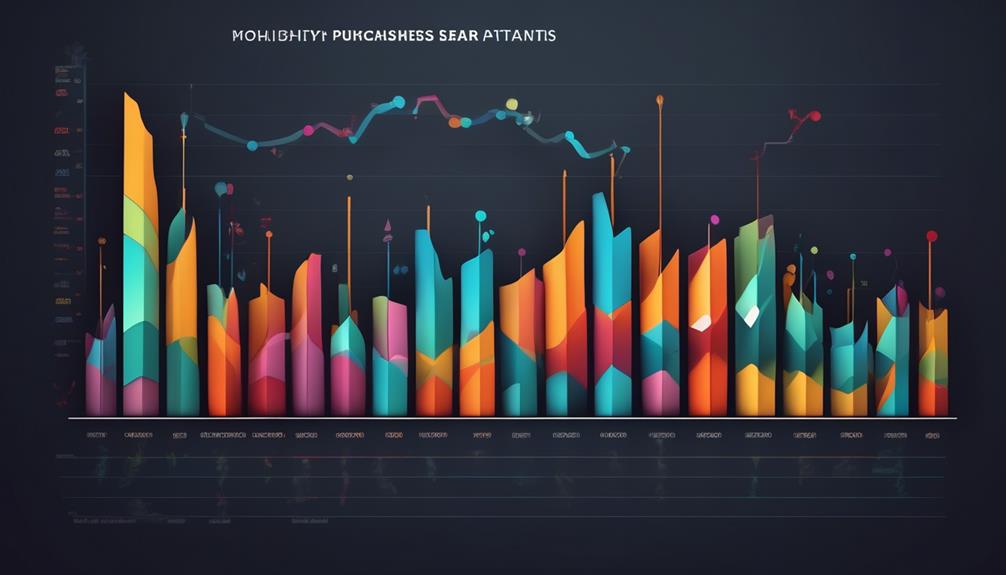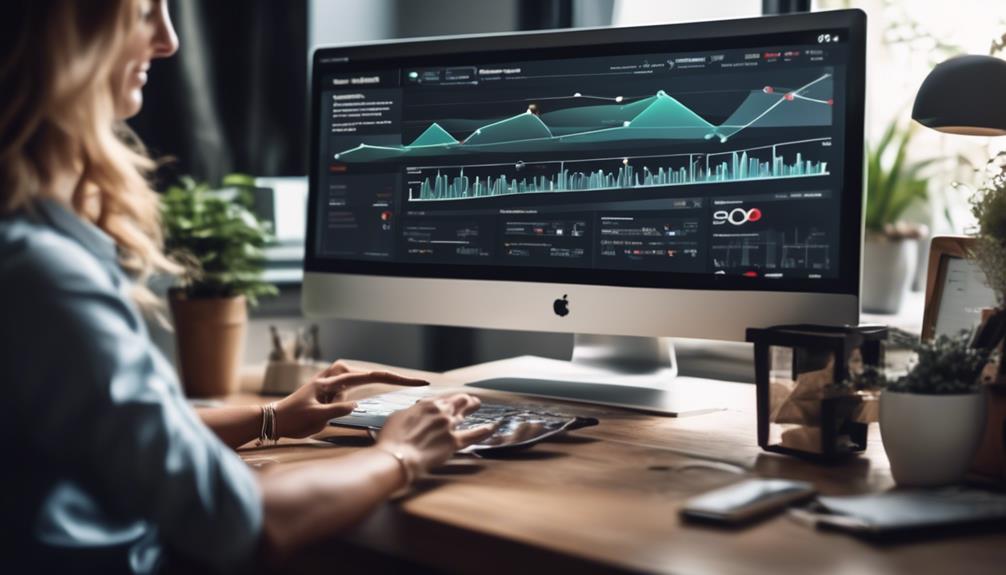Have you considered the improved effectiveness of your email marketing by using targeted segmentation, instead of just sending the same emails to all your subscribers?
By dividing your audience into smaller, targeted groups based on specific criteria, you can significantly improve engagement and conversion rates.
But what are the top email campaign segmentation strategies that can take your email marketing to the next level?
Let's explore some key segmentation tactics that can help you deliver more personalized and relevant content to your subscribers, ultimately driving better results for your email campaigns.
Key Takeaways
- Email segmentation can significantly improve open rates and clicks, leading to higher email revenue and repeat customer business.
- Demographic segmentation, such as age, gender, company position, income level, and location, can help tailor marketing messages to specific customer groups.
- Behavioral segmentation allows for analyzing customer preferences based on purchase history and website interactions, enabling personalized email campaigns.
- Email engagement segmentation is crucial to target active and inactive subscribers effectively, increasing overall engagement and implementing specialized campaigns for re-engagement.
Benefits of Email Segmentation
By segmenting your email campaigns, you can significantly increase open rates and clicks, leading to more engaged and responsive recipients. Email segmentation allows you to tailor your marketing messages to specific customer groups, resulting in more personalized and relevant content. This targeted approach based on segmentation criteria such as demographics, behavior, and preferences ensures that your emails are more effective in reaching the right audience.
Sending emails that are tailored to the specific needs and interests of different customer segments leads to higher email revenue and boosts repeat customer business.
Segmentation also enables you to send more targeted promotions and product recommendations, increasing the likelihood of conversion. By understanding the unique preferences and behaviors of different customer segments, you can create compelling and relevant content that resonates with your audience. This can result in improved customer satisfaction and loyalty, as customers feel understood and valued.
In essence, email segmentation allows you to deliver the right message to the right people at the right time, driving better results for your marketing campaigns.
Demographic Segmentation

To effectively utilize demographic segmentation in your email campaigns, identify the key demographic data that aligns with your target audience's needs and interests. By segmenting your customers based on demographic data such as age, gender, company position, and income level, you can tailor your email content to better resonate with different segments of your email subscribers. For instance, B2B software developers may find company position as an important demographic, while clothing retailers may prioritize gender. To help you understand how to segment users based on demographic data, here is a helpful table:
| Demographic Metric | Description |
|---|---|
| Age | Grouping subscribers based on age ranges |
| Gender | Segmenting based on male, female, or other |
| Company Position | Relevant for B2B businesses |
| Income Level | Useful for targeting different buying power |
| Location | Geographical segmentation |
Behavioral Segmentation
When it comes to behavioral segmentation in email campaigns, it's crucial to consider the points of purchase history, website interactions, and email engagement.
Understanding how subscribers have interacted with your brand allows you to tailor your marketing efforts to their specific behaviors.
Purchase History
Analyzing customers' purchase history allows for a deeper understanding of their preferences and the products they most frequently buy. This information is invaluable for targeted email campaigns and list segmentation. By segmenting customers based on their purchase history, you can effectively tailor your email campaigns to their specific interests and needs.
Here's how you can leverage purchase history to determine the most effective segmentation strategies:
- Identify accessories or repeat purchases that customers might need based on their purchase history.
- Create personalized messages and encourage repeat purchases using insights gained from purchase history.
- Gain insights into customer behavior and preferences by analyzing their purchase history.
- Tailor email campaigns to target customers with related product recommendations and complementary products based on their past purchases.
Website Interactions
By understanding visitors' interactions and behaviors on your website, you can effectively tailor your email campaigns to their specific interests and needs. Website behavior segmentation involves analyzing past actions and interactions to create targeted email campaigns. It includes tracking visitor interests, pages visited, and specific actions taken on the website to personalize email content. This allows for customized email content based on individual browsing history and preferences. Examples of behavioral segments include cart abandoners, frequent visitors to a particular product page, and subscribers who downloaded specific resources. Utilizing tools such as Kissmetrics can help collect and analyze behavioral data for effective segmentation.
| Behavioral Segments | Description | Email Campaign Strategy |
|---|---|---|
| Cart Abandoners | Visitors who added items to the cart but did not complete the purchase | Send reminder emails with personalized recommendations. |
| Frequent Product Visitors | Visitors who frequently view a specific product page | Send targeted product recommendations and special offers. |
| Resource Downloaders | Subscribers who downloaded specific resources | Follow up with related content and nurture them towards a purchase. |
Email Engagement
To enhance your email campaigns, consider segmenting your subscribers based on their engagement behaviors, allowing you to tailor content to their specific interactions with your emails.
Utilize the following strategies to optimize your email engagement segmentation:
- Identify and create segments for active and inactive subscribers in your email marketing lists.
- Send targeted emails to engaged subscribers based on their past interactions with your emails.
- Use email engagement metrics such as open rate and click-through rate to segment your email lists effectively.
- Implement specialized campaigns, such as abandoned cart emails, to re-engage inactive subscribers and increase overall engagement.
Geographic Segmentation

Geographic segmentation allows you to target specific regions based on climate or location, enabling you to deliver tailored content and promotions to your audience. By segmenting your email list using customer-based information and web analytics, you can send targeted emails to different geographic locations. This approach is particularly useful for businesses with physical stores, as it allows them to create regional promotions specific to certain store locations. Moreover, geographic segmentation enables you to stagger time-based email messages according to different time zones, ensuring that your audience receives communications at the most appropriate times.
In addition to promotions, geographic segmentation allows for the customization of content based on the recipient's location. This could include personalized travel directions, weather-related content, or location-specific product recommendations. By leveraging geographic segmentation, companies can enhance the customer experience and drive engagement.
Furthermore, this strategy can also be used to introduce new products or services tailored to the needs and preferences of specific geographic regions. For instance, Aramex successfully segmented its audience into over 20 different countries, allowing the company to deliver customized content and promotions, resulting in improved customer engagement and satisfaction.
Email Engagement Level

Leveraging your subscribers' interaction with emails, email engagement level segmentation categorizes them based on their level of activity and responsiveness to your email campaigns. This segmentation strategy allows you to target your subscribers more effectively, providing them with relevant content and customer-based information.
Here are four key strategies for leveraging email engagement level segmentation:
- Targeted Campaigns: Tailor your email campaigns based on the engagement level of your subscribers. Engaged users may respond well to specialized promotions or exclusive offers, while inactive users may need re-engagement tactics.
- Increased Engagement: By sending segmented emails to different engagement levels, you can increase engagement and responsiveness from your subscribers. Providing content that resonates with their level of activity can lead to higher interaction rates.
- Relevant Content Delivery: Segmenting based on email engagement allows you to send content that's more relevant to each subscriber's level of interest and interaction, increasing the likelihood of them opening, reading, and acting upon your emails.
- Enhanced Campaign Performance: Utilizing email engagement level segmentation can lead to improved campaign performance and subscriber engagement. By targeting specific engagement levels, you can optimize your email marketing efforts and achieve better results.
Implementing these strategies can help you make the most of your email marketing segmentation, ultimately leading to improved engagement and better campaign performance.
Purchase History

When it comes to your email campaign segmentation, your customers' purchase history holds valuable insights into their preferences and buying behavior.
Analyzing their transaction patterns allows you to identify the products they engage with the most and the accessories or related items they may need.
Understanding these points from their purchase history enables you to tailor personalized messages and offers that resonate with their buying habits.
Buyer Preferences
Understanding customer purchase history provides valuable insights into their preferences and buying behavior, allowing for more personalized and targeted marketing strategies. By leveraging this data, you can create relevant and engaging content that resonates with your customer base.
Here's how to optimize your email campaigns based on buyer preferences:
- Analyze the products that customers buy most often to understand their preferences.
- Identify accessories or repeat purchases they might need based on their purchase history.
- Use this information to craft personalized messages and targeted promotions to encourage repeat purchases.
- Segment your customer base based on their purchase history to gain insights into their behavior and preferences, allowing you to create tailored content and offers to match their interests.
Understanding buyer preferences through purchase history is crucial for creating effective buyer personas and delivering targeted marketing strategies.
Transaction Analysis
To effectively analyze transaction data, examine the products that your customers frequently purchase to gain a comprehensive understanding of their preferences and buying habits. By identifying the items that are frequently bought together or the accessories that complement certain products, you can segment your customers effectively. This segmentation allows you to personalize your marketing messages and offers, increasing the likelihood of repeat purchases. Understanding your customers' purchase history also provides valuable insights into their behavior and preferences, enabling you to tailor your email campaigns more effectively. Utilize your email marketing platform to track and analyze purchase history, including abandoned shopping carts, to create targeted and personalized campaigns that resonate with your customers and enhance their overall experience.
| Transaction Analysis | Benefits |
|---|---|
| Identify purchase preferences | Personalized messages and targeted offers |
| Understand buying habits | Insights into customer behavior and preferences |
Product Engagement
By analyzing your customers' purchase history, you can gain valuable insights into their preferences and behaviors, allowing you to effectively tailor your email campaigns.
Here's how to leverage product engagement through purchase history:
- Engage new subscribers: Use purchase history to introduce new customers to your product line, enticing them with items similar to their past purchases.
- Send highly targeted emails based on generative AI: Utilize advanced algorithms to create personalized messages and product recommendations directly linked to customers' purchase history.
- Encourage repeat customer purchases: Identify popular products and customer preferences through purchase history, then target customers with related items to encourage repeat purchases.
- Gain insights into customer behavior and preferences: Use purchase history to understand customer preferences and behaviors and tailor email campaigns effectively.
Customer Loyalty

Building customer loyalty involves creating positive experiences, providing excellent customer service, and offering quality products or services that keep customers coming back for more. When it comes to email marketing strategy, leveraging customer loyalty through segmentation can significantly impact your email campaigns. By segmenting your list based on customer loyalty, you can send highly targeted emails that resonate with your most loyal customers, driving engagement and fostering brand advocacy. Here's a breakdown of how you can segment your email list to cater to customer loyalty:
| Segmentation Strategy | Description | Example |
|---|---|---|
| Purchase Frequency | Segmenting based on how often customers make purchases. | Rewarding frequent buyers with exclusive offers. |
| Engagement Level | Categorizing customers based on their interaction with your brand. | Sending personalized emails to highly engaged customers. |
| Loyalty Program | Segmenting customers who are part of your loyalty program. | Offering special incentives to members of your loyalty program. |
Abandoned Cart

Target customers who've abandoned their shopping carts to recover lost sales and improve conversion rates. When it comes to the abandoned cart email campaign segmentation strategy, there are several key tactics to consider to effectively encourage users to revisit and complete their purchase:
- Segmentation: Utilize data to segment customers based on their browsing and purchasing behavior. Segmenting customers based on the products left in their carts can help in sending more targeted email content.
- Send More Targeted Email Content: Craft personalized and targeted email content that reminds customers about their abandoned carts. Include details about the items left in the cart and use persuasive language to encourage them to proceed with the purchase.
- Offer Incentives: Entice customers with incentives such as discounts, free shipping, or exclusive offers to motivate them to revisit their abandoned carts and complete the purchase.
- Follow-Up Emails: Send a series of follow-up emails at strategic time intervals to gently remind customers about their abandoned carts and the items they left behind, reinforcing the value of completing the purchase.
Email Preferences

When it comes to email preferences, understanding your audience's opt-in preferences, behavioral targeting, and desire for personalized content is crucial.
By segmenting based on these points, you can ensure that your subscribers receive the type of emails that they prefer, reducing unsubscribe rates and increasing engagement.
Tailoring your emails to match the specific interests and behaviors of your audience can lead to higher open rates and improved conversion rates.
Opt-In Preferences
To effectively utilize email campaign segmentation, understanding and respecting your subscribers' Opt-In Preferences (Email Preferences) is crucial. By doing so, you can create separate email lists and segment your subscribers based on their preferences, leading to more personalized and targeted content.
Here are some segmentation ideas based on Opt-In Preferences:
- Determine which customers prefer frequent emails and which ones prefer less frequent communication.
- Segment subscribers based on the lead magnets they've downloaded or the survey responses they've provided.
- Use Opt-In Preferences to address specific concerns or interests and tailor your email content accordingly.
- Segment customers based on their content preferences to ensure they receive relevant and engaging content. By doing this, you can enhance the way your subscribers interact with your emails.
Behavioral Targeting
Understanding and respecting your subscribers' Opt-In Preferences is essential for effective email campaign segmentation.
Now, let's explore how behavioral targeting further enhances the personalization of email campaigns based on subscribers' specific actions, interactions, and preferences.
Behavioral targeting allows you to segment your email list based on subscribers' behaviors, enabling you to target specific products or content that are highly relevant to them.
By analyzing valuable insights such as purchase history, browsing behavior, and email engagement, you can create targeted campaigns that resonate with individual subscribers.
This level of personalization not only increases engagement but also drives conversions by delivering content that aligns with each subscriber's interests and preferences.
Incorporating behavioral targeting into your segmentation strategies can significantly improve the effectiveness of your email campaigns.
Personalized Content
How can personalized content in email preferences enhance the engagement and satisfaction of your subscribers?
By tailoring content based on individual subscriber interests and choices, you can significantly improve engagement and satisfaction. Here's how to do it effectively:
- Segment your subscribers into different segments based on their preferences and behaviors.
- Send targeted emails that align with the demographic information and interests of each segment.
- Respect subscriber preferences by allowing them to choose their email frequency.
- Deliver relevant emails by segmenting based on lead magnets downloaded and survey responses.
Personalized content in email preferences not only increases engagement but also reduces unsubscribe rates, ensuring that your subscribers receive content that resonates with their specific needs and interests.
Lead Magnet

When creating an email campaign, selecting an enticing lead magnet is vital for capturing potential customer contact information. A lead magnet serves as a valuable incentive for individuals to provide their contact details in exchange for a specific piece of content. It could be a free eBook, whitepaper, checklist, webinar, or any other high-value offering.
The key to an effective lead magnet lies in its ability to address specific pain points and provide actionable solutions. By offering a lead magnet that's personalized and relevant to the different customer segments within your B2B and B2C audience, you can significantly increase the chances of capturing leads. It's crucial to understand the unique needs and preferences of your target audience and tailor the lead magnet accordingly.
Additionally, the lead magnet should align with the overall theme of your email messages and the specific segments you're targeting. Remember, the ultimate goal of a lead magnet isn't just to capture leads, but to engage and nurture prospects, eventually leading them towards conversion.
Survey Responses

When it comes to survey responses, you can effectively target audience groups based on their preferences and behaviors.
By analyzing the behavioral data obtained from surveys, you can personalize your content creation and offerings to cater to the specific needs and interests of different segments.
This targeted approach allows you to create more engaging and relevant email campaigns that resonate with your subscribers.
Targeted Audience Groups
To effectively target audience groups based on survey responses, utilize customizable email sign-up questions or plugins to gather valuable demographic information and preferences. By doing so, you can segment lists based on email engagement stats like open rate and clickthrough rate to target specific audience groups.
Use survey responses to gather nuanced customer data and personalize email content according to preferences and interests. Additionally, tailor email content based on specific pages visited on the website to create personalized emails for targeted audience groups.
These strategies will help you optimize your email campaign segmentation, increase the effectiveness of your sales funnel, and deliver tailored content that resonates with your audience, ultimately leading to higher engagement and conversions.
Personalized Content Creation
After effectively targeting audience groups based on survey responses and demographic information, the next step is to utilize these insights for personalized content creation in your email campaigns.
By incorporating survey responses into your email campaign segmentation, you can tailor content to specific subscriber interests, increasing engagement and response rates.
Use the information gathered from surveys to segment subscribers and target them with personalized offers and recommendations. This targeted approach ensures that your subscribers receive content that's relevant to their preferences and interests, leading to a more compelling email campaign.
Understanding subscriber preferences and interests allows you to create tailored content that resonates with your audience, ultimately driving better results.
Take the time to analyze survey responses and create different content for different segments to maximize the impact of your email campaigns.
Behavioral Data Analysis
Utilize survey responses to gather valuable demographic information, tastes, preferences, and beliefs, enabling you to understand your subscribers' behaviors and interests more comprehensively.
When it comes to behavioral data analysis for segmentation strategies, consider the following:
- Email Engagement: Segment lists based on email engagement stats like open rate and clickthrough rate to re-engage inactive subscribers and target engaged subscribers more precisely for specialized campaigns.
- Past Purchases: Segment based on past purchases to personalize recommendations and send targeted emails for similar items or accessories.
- Amount Spent: Use amount spent as an effective segmentation strategy to determine customers likely to buy more expensive or affordable items and send targeted emails featuring products within each person's budget.
- Customer Feedback: Segment based on customer feedback and survey responses, targeting specific concerns or interests identified through feedback.
Membership Type

Segmenting your email campaigns based on membership type allows you to deliver personalized content and offers tailored to the specific needs and interests of different levels of membership or subscription services.
By categorizing your audience into different membership types, you can send targeted and relevant emails that resonate with their specific interests and engagement levels.
For instance, you can send different email communications to new members, long-term subscribers, or those who've lapsed in their engagement.
This segmentation strategy enables you to provide the right type of content to each group, increasing the likelihood of them making a purchase or engaging further with your brand.
Understanding the distinct behaviors and needs of each membership type is crucial for crafting effective email campaigns that drive customer satisfaction and loyalty.
Seasonal Purchasing Behavior

Understanding your customers' seasonal purchasing behavior is essential for crafting targeted email campaigns that align with their changing buying habits throughout the year. By segmenting your email campaigns based on seasonal purchasing behavior, you can effectively tailor your marketing efforts to capitalize on specific times of the year when customers are more inclined to make purchases.
Here are four key strategies for leveraging seasonal purchasing behavior in your email campaigns:
- Tailored Promotions: Offer promotions and discounts that are relevant to the seasonal needs and preferences of your customers, such as holiday-themed sales or back-to-school offers.
- Product Recommendations: Adjust your product recommendations within your email campaigns to align with seasonal trends and anticipated customer demand based on specific occasions or weather patterns.
- Inventory Management: Anticipate and adjust your inventory based on seasonal purchasing behavior to ensure that you have the right products in stock at the right times.
- Position in the Sales Funnel: Recognize how seasonal purchasing behavior affects your customers' position in the sales funnel, and craft email campaigns that address their specific needs and preferences at various stages.
Technology Usage

When targeting your audience for email campaigns, considering their technology usage is essential for delivering personalized and optimized user experiences. Understanding how your customers engage with digital platforms and their device preferences provides valuable information for tailoring your email content and design. By segmenting based on technology usage, you can deliver targeted and personalized emails to send early access to new products or promotions specific to certain devices or platforms. Utilizing website forms to gather information about preferred devices or digital habits can further enhance your segmentation strategy. Here's a table illustrating the importance of technology usage in email campaign segmentation strategies:
| Technology Usage Segmentation | Benefits |
|---|---|
| Device Compatibility | Ensures emails are optimized for various devices |
| Digital Platform Engagement | Tailors content for specific platforms |
| Personalized Content | Delivers relevant promotions based on technology preferences |
| User Experience Optimization | Enhances engagement through targeted content |
| Early Access Opportunities | Provides exclusive access to new products or features |
Frequently Asked Questions
What Is the Best Way to Run Segmented Email Campaign?
To run a segmented email campaign effectively, you should focus on understanding your audience and their preferences. Tailor your content according to their demographics and past behaviors.
Engage new subscribers with personalized onboarding emails. Reward loyal customers with exclusive deals to show appreciation.
Separate B2B and B2C customers and provide relevant content. By implementing these strategies, you can maximize the impact of your email campaigns and drive better results.
What Is the Most Effective Email Marketing Campaign Strategy?
The most effective email marketing campaign strategy involves understanding your audience and tailoring your content to meet their needs.
By utilizing demographic segmentation, you can target specific groups based on personal characteristics.
Behavioral segmentation allows for personalized content delivery based on past actions and interactions.
Engaging new subscribers through onboarding email campaigns and personalization, while rewarding loyal customers with exclusive deals, are essential strategies.
Additionally, segmenting based on customer personas and launching targeted campaigns based on customer interests can significantly boost your email marketing effectiveness.
What Is Segmentation in an Email Campaign?
Segmentation in an email campaign involves dividing your email list into smaller, targeted segments based on specific criteria. This allows you to personalize and tailor content to different audience groups, increasing engagement and conversion rates.
What Is the Best Segmentation Strategy?
To achieve the best segmentation strategy, consider your audience's demographics, behaviors, and engagement levels. Personalize emails based on age, gender, and purchase history, creating targeted segments.
Engage new subscribers with onboarding campaigns and tailor content to preferences. Reward loyal customers with exclusive deals and content.
For B2B customers, provide business-specific emails. By implementing these strategies, you can effectively communicate and boost conversion rates, leading to higher satisfaction and retention.
Conclusion
You've now unlocked the treasure trove of email campaign segmentation strategies. By tailoring your emails to the specific needs and behaviors of your subscribers, you can hit the bullseye with your messaging every time.
It's like having a personalized map to guide your subscribers through a lush, green garden of engagement and conversion.
So go forth and conquer the email marketing world with your newfound segmentation knowledge!










